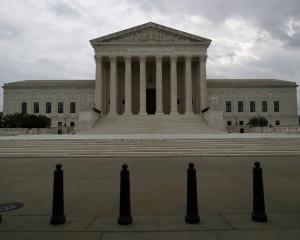The news that our terrorism alert levels have gone from very low to low in the past few weeks has brought to mind those swingometer rural fire warning rainbow charts.
You've seen them, right? Colour-coded danger ratings from very low to extreme.
From calm go-have-a-fire-so-long-as-you've-got-a-permit-kids green to don't-even-consider-it-you-crazy-pyromaniac fire-engine red.
It's the traffic light motif of safe and dangerous played out over half a pie.
Since there is a total fire ban at the height of the summer, code red is a kind of moot point in fire terms, but the arrowed warnings must serve some useful purpose - a reminder to smokers to think again before they flick butts out of the car window?
A hope for behaviour modification?
Think before you lawn-mow because a spark from a blade and an errant stone can cause mayhem.
I've seen it. Be vigilant! Be a little more vigilant!
Be massively, beetrootly 10-out-of-10 vigilant! We told you so.
When it comes to a terror alert, I picture a swingometer billboard on the Beehive lawn, with the arrow now raised a slim shade higher.
Be vigilant, people.
The risk is low. It was, like, one out of 10 and now it's two.
And if you translate that to actual stats and multiply by the secret formula then all you really need to know is you're required to act a little bit more suspicious and scared.
Just like the nice arrow says.
It's not like there's any other behavioural changes we can make.
Only law changes and foreign-baddie-fighting for our own protection at home.
Of course.
Presumably there's already a total terrorism ban (and a brilliant play on words to be made somewhere about a Taliban ban but this isn't it) and the rest is all hush hush secret squirrel spy.
But there's no smoke without fire.
Except if you're smoking. And smoking is bad, too. And banned.
If we're going to get all trendy with shared risk analysis in the honeycombed corridors of power, we could at least apply it to things that are somewhat within our control.
Pollution level swingometer signs on all the waterways apparently not affected by dairy farming.
The property-market-madness-ometer.
The rising poverty chart of shame.
The ebolameter, swinging wildly every day, would give whoever is responsible for tweaking the arrows a real sense of purpose and pride.
So much to do. So many threats, so much risk.
So much conjecture. Oh joy.
It would be deceptively simple to apply the same logic at home.
A hungryometer to hover over the kids.
Ravenous or just playing up?
An extra-easy weather chart for public holidays.
Because why bother researching for yourself whether you need to take a raincoat.
The answer is always yes, anyway.
An app to assess how much your brain will atrophy from watching an entire episode of reality TV. (Clue: This app only has one setting - extreme danger.)
Why use such simple media to communicate, anyway?
Well, as humans we are mostly visual learners, who like to look for patterns in things.
And while we like to be informed, we're told that we don't have time to properly listen to or digest news, which is why it's given to us in handy soundbites and traffic-light simplicity.
The great thing about charts, for those behind them, is that they demonstrate a singular trajectory of authority.
Easy to understand but hardly ever the whole story.
Swingometers were the vogue long before reality shows co-opted them.
They've been a mainstay of political elections since 1955 in the UK; some sources ascribe them further back, to the work of New Zealand psephologist and founding professor of political studies at Auckland University, Robert Chapman.
They work really well on a straight line with two opposing forces - fire/safety, good/bad, green/red, red/blue.
But it's not so easy when other elements come into play. And that's where my comparison falls apart.
Life's too plural for certainties of swing.












